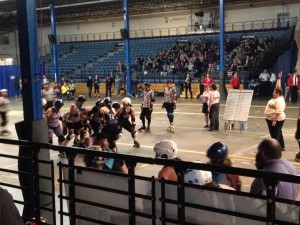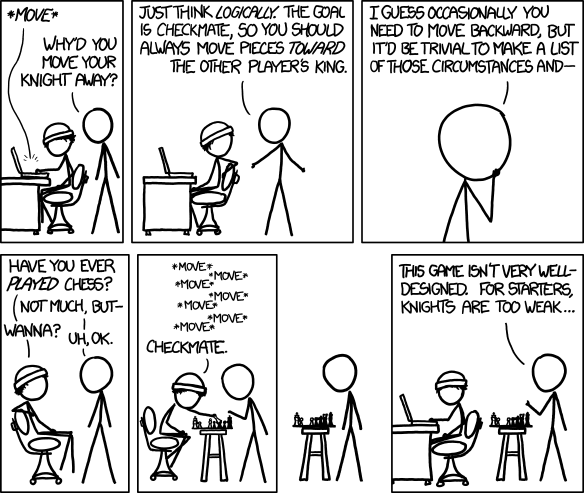In one of my all-time favorite newspaper articles, the author asserts:
“Everyone should listen to what I have to say and heed my advice because I am correct … One of the things I like best about myself is that not only do I know what is best for everyone, I always make sure to come forward with this information.” (Edwin Wiersbicki, “I Know What Is Best For Everyone“, The Onion 34(12): 21 Oct 1998)
Following in Mr. Wiersbicki’s bold example, I myself have a few suggestions to offer to the Women’s Flat Track Derby Association (WFTDA)—the international governing body of women’s flat track roller derby—even though
- I am not a woman,
- I have never participated in a roller derby game,
- I haven’t even been on quad roller skates in probably 20 years, and
- I wasn’t really clear on the concepts and principles behind flat track roller derby until I watched a game last night.
(For example, it didn’t register to me flat track roller derby is played on a flat track, unlike the delightful banked-track sport a young John found himself glued to on television on Saturdays in 1989.)
I’d been wanting to attend a Boston Derby Dames match for the past two years, ever since I heard that Boston had an active roller derby team. And last night I did! It was a doubleheader, featuring a B-league matchup (Boston B-Party vs. Charm City Female Trouble) and the main event (Boston Massacre vs. Charm City All-Stars).
The skater names these athletes choose for themselves are hilarious. A few that I texted to Evelyn: “Boston Creamer”, “M.C. Slammer”, “Allie B. Back”, “I. M. Pain”. Even the officials were in on the fun: “Buxom Melons”, “TestosteRon Jeremy”.
As a novice spectator it was pretty hard to follow along with the action until two former skaters sitting near me (one named “Jodie Faster”) patiently explained what was going on. The key principles:
- A 60-minute game is made up of a series of 2-minute “jams”.
- A jam is 5-on-5 skating in a counterclockwise direction.
- In a jam, each team fields one “jammer” (similar to a football quarterback) and four blockers.
- Jammers score points by lapping members of the other team.
- Blockers try to (a) stop the other jammer from lapping them, and (b) disrupt the other blockers so that their jammer can make progress. Skaters are not allowed to grasp with their hands, so hip checks are common.
- It’s not (much) violence! Rather, strategy and agility are important. Brute force only gets you so far.
That last bullet was my favorite part of watching the games: As the game wore on, and the blockers became more familiar with the jammers’ jukes, and the skaters collectively grew more tired, and more skaters got sent to the penalty box (yielding 5-on-4 or 5-on-3 skating), it was very interesting to watch the teams shift their strategies—switching up personnel to get more favorable matchups; lining up differently at the start of a jam; inducing the pack of blockers to move more quickly or more slowly around the rink; trapping a skater on one side of the track and forcing her out of bounds; making use of a quirky rule to switch which skater is declared the jammer in the middle of a jam.
Protip: In order to notice these things it was very helpful to be sitting next to Jodie and Brittany; I highly recommend that anyone new to roller derby make it a point to sit next to people who look like former or current skaters.
An interesting aspect of the roller derby leagues [according to my guides] is that it takes up about 20 hours a week for each of the team members (on top of their full time jobs needed to pay for skating equipment)—not just practice time, but also business activities such as reserving venues or merchandising or soliciting sponsors. As an away game, the teams from Baltimore likely drove themselves up I-95 and stayed at skaters’ houses to save money. Somehow knowing that each skater had an integral role in the functioning of the team and the league (instead of, say, a small powerful board taking care of such details) made the skating more fun to watch.
The games were held at the nifty Shriners Auditorium in Wilmington. $16 for a general admission ticket plus two $4 cheeseburgers and a $5 Shock Top beer (all served by genuine Shriners!) worked out to about $7.25 per hour of entertainment. Pretty good value, especially since the A-teams turned out to be well matched. Both games featured several lead changes, and the major game stayed nail-bitingly close into the final minute—generating thunderous excitement from the audience of about 700. (The audience seemed to consist mostly of current skaters, former skaters, friends of skaters, or partners of skaters.)
I had a good time, though I doubt I’d go back to see another game. There are two perplexing rules whose enforcement took away a big part of my enjoyment of the games. One rule imposes a grossly unfair penalty for infractions by a certain class of skater (a violation of the Equal Protection Clause). The other rule flushes down the toilet almost about 75% of the opportunities for skaters to demonstrate strategy and agility (“my favorite part of watching the games”, as described above). These two rules vexed me so much that they inspired me to write this blog post to suggest that the rules be changed.
So, to the WFTDA, here are my three unsolicited recommendations:
- Eliminate penalties that send jammers to the penalty box (6.1.1). Each time you send off a jammer it’s a blank check for the other team to score 15 to 20 unanswered points. Baltimore lost by 14 points last night, in a game where three seemingly bogus penalties on Baltimore jammers netted about 45 total points for Boston.
The disparity in impact between a blocker getting a penalty (perhaps 3 points) and a jammer getting a penalty (15+ points)—for the same infraction—is absurd. This rule should be changed. Perhaps a jammer’s penalty should be immediately served by a blocker, as is done with penalties against goalies in hockey? (I note that other writers have proposed other rule changes for jammer penalty enforcement.)
Certainly other sports have asymmetric positional rule impact. For example, in this article Gregg Easterbrook complains about asymmetric football rules such as holding, where offensive holding is a 10-yard penalty and replay the down, whereas defensive holding is a 10-yard penalty and an automatic first down:
Under current rules, the defense is penalized more than the offense for the same foul. Let’s make defensive and offensive holding equivalent.
But back to roller derby, the rule to send off jammers for penalties is one of the worst rules I’ve ever seen in sports.
- Limit (or eliminate) the concept of Lead Jammer calling off the jam (2.4.7). It is truly dull from an audience perspective to watch the jammer make one loop of the track, pass the blockers, and immediately call off the jam for a ho-hum 4-0 score. You’re wasting 90 seconds of potentially audience-stimulating action!
Yes, the current rule makes it valuable to be the Lead Jammer, but there are many ways that the rules could be improved to preserve the value of being the first jammer out of the gate:
- Teams could be limited in the number of times per half that a jammer could call off the jam, making it a strategic (instead of tactical) decision for when to call off the jam.
- The Lead Jammer (or perhaps just the jammer currently in the lead) could receive a bonus point every time she laps the pack, or bonus points just for being the Lead Jammer (cf. NASCAR points for leading the most laps in a race).
- The Lead Jammer could accumulate more than 1.0 point for each blocker passed, or could receive another scoring modifier.
- Jammers could only be eligible to call off the jam if in the lead under certain conditions (for example in every other jam [cf. vulnerability in Bridge], or only when trailing in score, or only in the first half of the period).
I felt this rule was just plain dumb. For the first 20 minutes of action I couldn’t figure out why the jams were ending with time still left on the jam clock. Once it was explained to me, I couldn’t fathom why the rules authority would go out of its way to make the game boring to its audience.
- Eliminate some of the 30-second delays between jams (1.5.3). Instead of having a new set of personnel out to line up start ever discrete jam, consider having a continuous “extended jam” concept where winded skaters are allowed to be replaced with fresh skaters while the action continues around them (as in relay speed skating, or hockey, or tag-team wrestling).
The personnel changes could happen continuously (for example by a skater tagging out with another skater in the clearance area outside the track); or they could happen on a referee’s whistle at 2-minute intervals. Scoring could continue with whichever skater is currently wearing the star helmet. Perhaps the last 10 minutes of each period could be skated under the “extended jam” concept?
(This rule isn’t something that vexed me, but I feel such a change would be interesting to try and could make the games more interesting for players and spectators alike.)
Anyone from the WFTDA Rules Committee is welcome to contact me (see instructions on this page); I would be happy to elaborate on any of the above three points.

